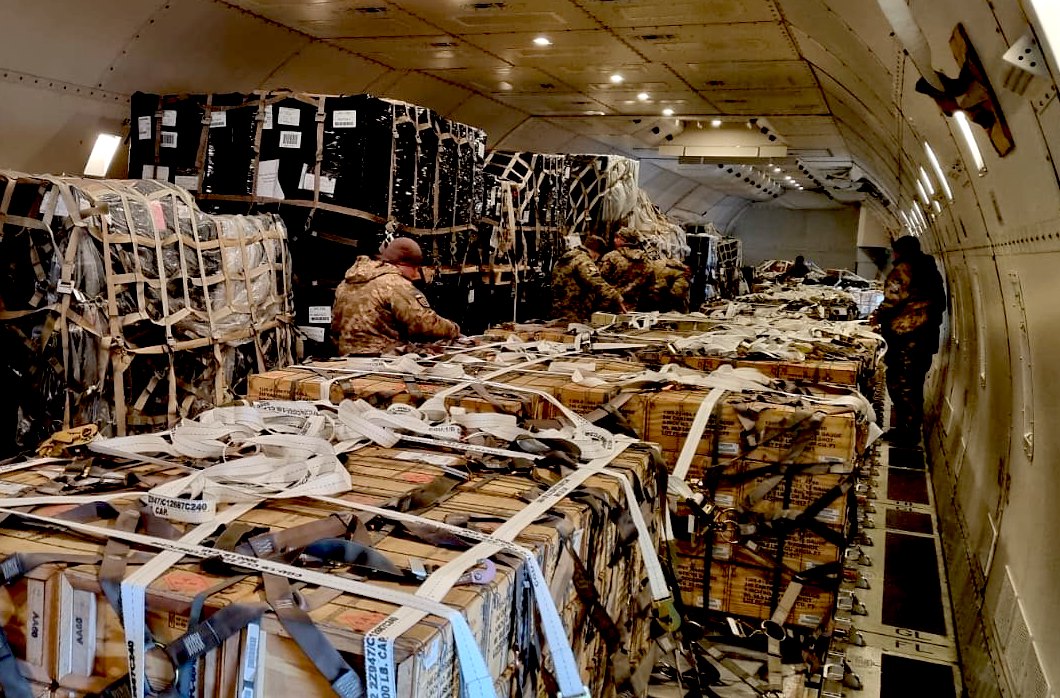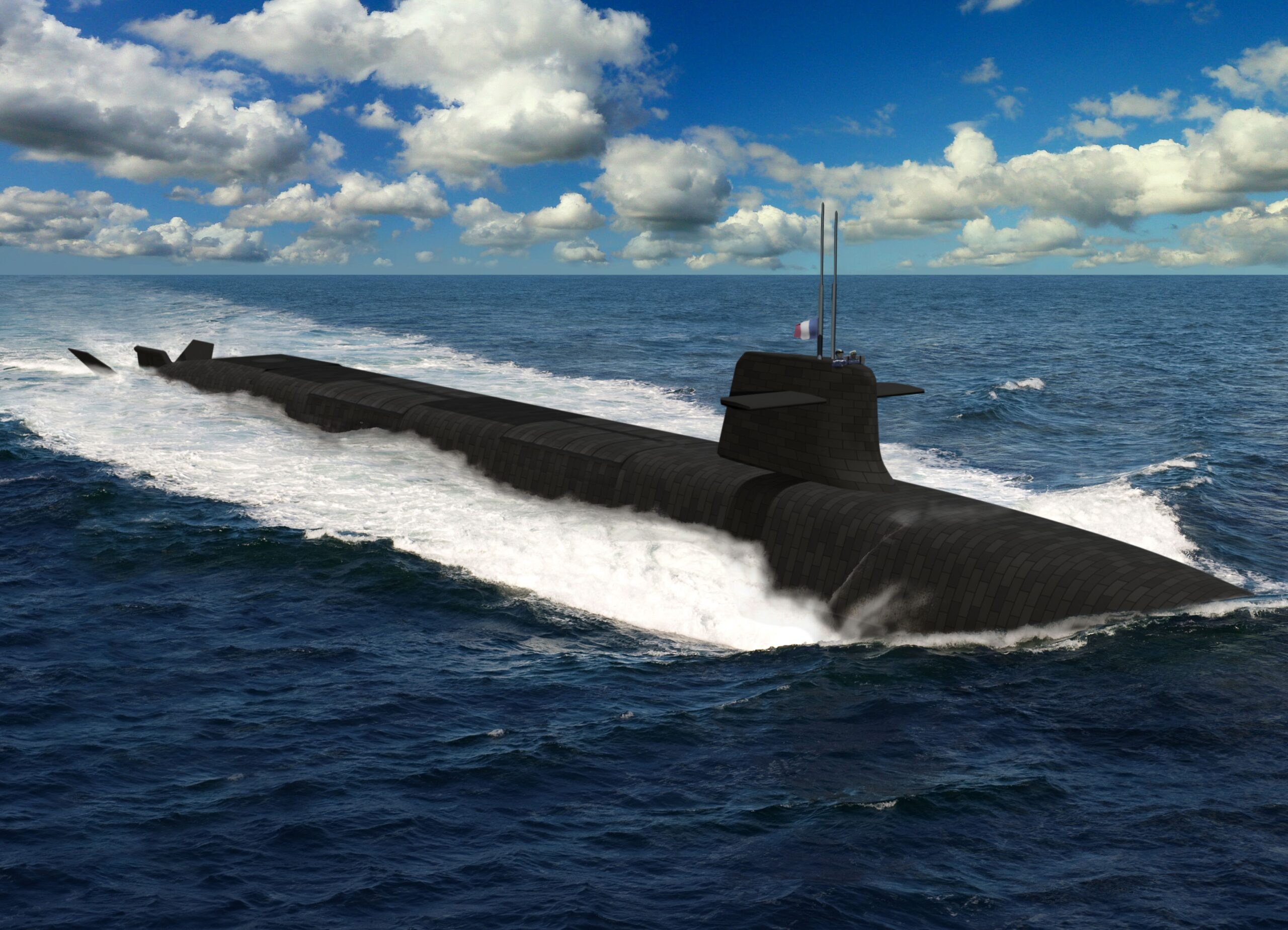Even before hostilities broke out, the CEOs of major weapons firms were talking about how tensions in Europe could pad their profits, William D. Hartung and Julia Gledhill report.

Anthem playing for U.S. Secretary of Defense Lloyd Austin and and Ukraine Minister of Defense Oleksii Reznikov at the Pentagon on Nov. 16, 2021. (DoD, Jack Sanders)
By William D. Hartung and Julia Gledhill
TomDispatch.com

 The Russian invasion of Ukraine has brought immense suffering to the people of that land, while sparking calls for increased military spending in both the United States and Europe. Though that war may prove to be a tragedy for the world, one group is already benefiting from it: U.S. arms contractors.
The Russian invasion of Ukraine has brought immense suffering to the people of that land, while sparking calls for increased military spending in both the United States and Europe. Though that war may prove to be a tragedy for the world, one group is already benefiting from it: U.S. arms contractors.
Even before hostilities broke out, the CEOs of major weapons firms were talking about how tensions in Europe could pad their profits.
In a January 2022 call with his company’s investors, Raytheon Technologies CEO Greg Hayes typically bragged that the prospect of conflict in Eastern Europe and other global hot spots would be good for business, adding that
“we are seeing, I would say, opportunities for international sales… [T]he tensions in Eastern Europe, the tensions in the South China Sea, all of those things are putting pressure on some of the defense spending over there. So I fully expect we’re going to see some benefit from it.”
In late March, in an interview with the Harvard Business Review after the war in Ukraine had begun, Hayes defended the way his company would profit from that conflict:
“So I make no apology for that. I think again recognizing we are there to defend democracy and the fact is eventually we will see some benefit in the business over time. Everything that’s being shipped into Ukraine today, of course, is coming out of stockpiles, either at DoD [the Department of Defense] or from our NATO allies, and that’s all great news. Eventually we’ll have to replenish it and we will see a benefit to the business over the next coming years.”
Arms to Ukraine, Profits to Contractors

Raytheon’s campus in Richardson, Texas, 2016. (Jpalens, CC BY-SA 4.0, Wikimedia Commons)
The war in Ukraine will indeed be a bonanza for the likes of Raytheon and Lockheed Martin. First of all, there will be the contracts to resupply weapons like Raytheon’s
and the Raytheon/Lockheed Martin-produced Javelin anti-tank missile that Washington has already provided to Ukraine by the thousands.
The bigger stream of profits, however, will come from assured post-conflict increases in national-security spending here and in Europe justified, at least in part, by the Russian invasion and the disaster that’s followed.
Indeed, direct arms transfers to Ukraine already reflect only part of the extra money going to U.S. military contractors. This fiscal year alone, they are guaranteed to also reap significant benefits from the Pentagon’s Ukraine Security Assistance Initiative (USAI) and the State Department’s Foreign Military Financing (FMF) program, both of which finance the acquisition of American weaponry and other equipment, as well as military training.
These have, in fact, been the two primary channels for military aid to Ukraine from the moment the Russians invaded and seized Crimea in 2014. Since then, the United States has committed around $5 billion in security assistance to that country.

U.S. Marine firing an FIM-92 Stinger missile during a July 2009 training exercise in California. (U.S. Marine Corp, Christopher O’Quin)
According to the State Department, the United States has provided such military aid to help Ukraine “preserve its territorial integrity, secure its borders, and improve interoperability with NATO.”
So, when Russian troops began to mass on the Ukrainian border last year, Washington quickly upped the ante. On March 31, 2021, the U.S. European Command declared a “potential imminent crisis,” given the estimated 100,000 Russian troops already along that border and within Crimea.
As last year ended, the Biden administration had committed $650 million in weaponry to Ukraine, including anti-aircraft and anti-armor equipment like the Raytheon/Lockheed Martin Javelin anti-tank missile.
Despite such elevated levels of American military assistance, Russian troops did indeed invade Ukraine in February. Since then, according to Pentagon reports, the U.S. has committed to giving approximately $2.6 billion in military aid to that country, bringing the Biden administration total to more than $3.2 billion and still rising.
Some of this assistance was included in a March emergency-spending package for Ukraine, which required the direct procurement of weapons from the defense industry, including drones, laser-guided rocket systems, machine guns, ammunition, and other supplies.
The major military-industrial corporations will now seek Pentagon contracts to deliver that extra weaponry, even as they are gearing up to replenish Pentagon stocks already delivered to the Ukrainians

U.S. military aid delivery, Jan 28. (U.S. Embassy Kyiv)
On that front, in fact, military contractors have much to look forward to. More than half of the Pentagon’s $6.5 billion portion of the emergency-spending package for Ukraine is designated simply to replenish DoD inventories. In all, lawmakers allocated $3.5 billion to that effort, $1.75 billion more than the president even requested.
They also boosted funding by $150 million for the State Department’s FMF program for Ukraine. And keep in mind that those figures don’t even include emergency financing for the Pentagon’s acquisition and maintenance costs, which are guaranteed to provide more revenue streams for the major weapons makers.
U.S. lawmakers allocated $3.5 billion to replenish DoD inventories, $1.75 billion more than the president even requested.
Better yet, from the viewpoint of such companies, there are many bites left to take from the apple of Ukrainian military aid. President Joe Biden has already made it all too clear that “we’re going to give Ukraine the arms to fight and defend themselves through all the difficult days ahead.” One can only assume that more commitments are on the way.
Another positive side effect of the war for Lockheed, Raytheon and other arms merchants like them is the push by House Armed Services Committee chair Adam Smith (D-WA) and ranking committee Republican Mike Rogers of Alabama to speed up production of a next-generation anti-aircraft missile to replace the Stinger.
In his congressional confirmation hearing, William LaPlante, the latest nominee to head acquisition at the Pentagon, argued that America also needs more “hot production lines” for bombs, missiles, and drones. Consider that yet another benefit-in-waiting for the major weapons contractors.
The Pentagon Gold Mine
For U.S. arms makers, however, the greatest benefits of the war in Ukraine won’t be immediate weapons sales, large as they are, but the changing nature of the ongoing debate over Pentagon spending itself. Of course, the representatives of such companies were already plugging the long-term challenge posed by China, a greatly exaggerated threat, but the Russian invasion is nothing short of manna from heaven for them, the ultimate rallying cry for advocates of greater military outlays.
Even before the war, the Pentagon was slated to receive at least $7.3 trillion over the next decade, more than four times the cost of President Biden’s $1.7 trillion domestic Build Back Better plan, already stymied by members of Congress who labeled it “too expensive” by far. And keep in mind that, given the current surge in Pentagon spending, that $7.3 trillion could prove a minimal figure.
Indeed, Pentagon officials like Deputy Secretary of Defense Kathleen Hicks promptly cited Ukraine as one of the rationales for the Biden administration’s proposed record national-security budget proposal of $813 billion, calling Russia’s invasion “an acute threat to the world order.”
“For U.S. arms makers … the greatest benefits of the war in Ukraine … will be the changing nature of the ongoing debate over Pentagon spending itself.”
In another era that budget request for Fiscal Year 2023 would have been mind-boggling, since it’s higher than spending at the peaks of the conflicts in Korea and Vietnam and over $100 billion more than the Pentagon received annually at the height of the Cold War.
Despite its size, however, congressional Republicans — joined by a significant number of their Democratic colleagues — are already pushing for more.
Forty Republican members of the House and Senate Armed Services Committees have, in fact, signed a letter to President Biden calling for 5 percent growth in military spending beyond inflation, which would potentially add up to $100 billion to that budget request.
Typically enough, Representative Elaine Luria (D-VA), who represents the area near the Huntington Ingalls company’s Newport News military shipyard in Virginia, accused the administration of “gutting the Navy” because it contemplates decommissioning some older ships to make way for new ones. That complaint was lodged despite that service’s plan to spend a whopping $28 billion on new ships in FY 2023.
Who Benefits?

Nov. 11, 2000: The island structure of the aircraft carrier Ronald Reagan is lifted into place at Newport News Shipbuilding. (U.S. Navy, Wikimedia Commons)
That planned increase in shipbuilding funds is part of a proposed pool of $276 billion for weapons procurement, as well as further research and development, contained in the new budget, which is where the top five weapons-producing contractors — Lockheed Martin, Boeing, Raytheon, General Dynamics and Northrop Grumman — make most of their money.
Those firms already split more than $150 billion in Pentagon contracts annually, a figure that will skyrocket if the administration and Congress have their way.
To put all of this in context, just one of those top five firms, Lockheed Martin, was awarded $75 billion in Pentagon contracts in fiscal year 2020 alone. That’s considerably more than the entire budget for the State Department, dramatic evidence of how skewed Washington’s priorities are, despite the Biden administration’s pledge to “put diplomacy first.”
The Pentagon’s weapons wish list for FY 2023 is a catalog of just how the big contractors will cash in. For example, the new Columbia Class ballistic missile submarine, built by General Dynamics Electric Boat plant in southeastern Connecticut, will see its proposed budget for FY 2023 grow from $5.0 billion to $6.2 billion.

Artist rendering of a Columbia-class ballistic missile submarine, 2019. (U.S. Navy, Wikimedia Commons)
Spending on Northrop Grumman’s new intercontinental ballistic missile (ICBM), the Ground Based Strategic Deterrent, will increase by about one-third annually, to $3.6 billion. The category of “missile defense and defeat,” a specialty of Boeing, Raytheon, and Lockheed Martin, is slated to receive more than $24 billion.
And space-based missile warning systems, a staple of the Trump administration-created Space Force, will jump from $2.5 billion in FY 2022 to $4.7 billion in this year’s proposed budget.
Among all the increases, there was a single surprise: a proposed reduction in purchases of the troubled Lockheed Martin F-35 combat aircraft, from 85 to 61 planes in FY 2023. The reason is clear enough. That plane has more than 800 identified design flaws and its production and performance problems have been little short of legendary. Luckily for Lockheed Martin, that drop in numbers has not been accompanied by a proportional reduction in funding. While newly produced planes may be reduced by one-third, the actual budget allocation for the F-35 will drop by less than 10 percent, from $12 billion to $11 billion, an amount that’s more than the complete discretionary budget of the Centers for Disease Control and Prevention.

Lockheed Martin exhibit at the April 2016 USA Science and Engineering Festival. (Alexander Rea, CC BY 4.0, Wikimedia Commons)
Since Lockheed Martin won the F-35 contract, development costs have more than doubled, while production delays have set the aircraft back by nearly a decade.
Nonetheless, the military services have purchased so many of those planes that manufacturers can’t keep up with the demand for spare parts. And yet the F-35 can’t even be properly tested for combat effectiveness because the simulation software required is not only unfinished, but without even an estimated completion date. So, the F-35 is many years away from the full production of planes that actually work as advertised, if that’s ever in the cards.
A number of the weapons systems which, in the Ukraine moment, are guaranteed to be showered with cash are so dangerous or dysfunctional that, like the F-35, they should actually be phased out.
Take the new ICBM. Former Secretary of Defense William Perry has called ICBMs “some of the most dangerous weapons in the world” because a president would only have minutes to decide whether to launch them in a crisis, greatly increasing the risk of an accidental nuclear war based on a false alarm. Nor does it make sense to buy aircraft carriers at $13 billion a pop, especially since the latest version is having trouble even launching and landing aircraft — its primary function — and is increasingly vulnerable to attack by next-generation high-speed missiles.
“A number of the weapons systems … guaranteed to be showered with cash are so dangerous or dysfunctional … they should be phased out.”
The few positives in the new budget like the Navy’s decision to retire the unnecessary and unworkable Littoral Combat Ship — a sort of “F-35 of the sea” designed for multiple tasks none of which it does well — could easily be reversed by advocates from states and districts where those systems are built and maintained.
The House of Representatives, for instance, has a powerful Joint Strike Fighter Caucus, which, in 2021, mustered more than one-third of all House members to press for more F-35s than the Pentagon and Air Force requested, as they will no doubt do again this year.
A Shipbuilding Caucus, co-chaired by representatives Joe Courtney (D-CT) and Rob Wittman (R-VA), will fight against the Navy’s plan to retire old ships to buy new ones. (They would prefer that the Navy keep the old ones and buy new ones with more of your tax money up for grabs.) Similarly, the “ICBM Coalition,” made up of senators from states with either ICBM bases or production centers, has a near perfect record of staving off reductions in the deployment or funding of those weapons and will, in 2022, be hard at work defending its budgetary allocation.
Towards a New Policy

U.S. Military in Space in 2030 forum in Washington, April 29, 2019. Seated on right: Wallis Laughrey, vice president, Space Systems, Raytheon. (New America, Flickr, CC BY 2.0)
Coming up with a sensible, realistic, and affordable defense policy, always a challenge, will be even more so in the midst of the Ukrainian nightmare. Still, given where our taxpayer dollars go, it remains all too worthwhile. Such a new approach should include things like reducing the numbers of the Pentagon’s private contractors, hundreds of thousands of people, many of whom are engaged in thoroughly redundant jobs that could be done more cheaply by civilian government employees or simply eliminated. It’s estimated that cutting spending on contractors by 15 percent would save around $262 billion over 10 years.
The Pentagon’s three-decades-long near $2 trillion “modernization” plan to build a new generation of nuclear-armed bombers, missiles, and submarines, along with new warheads, should, for instance, simply be scrapped in keeping with the kind of “deterrence-only” nuclear strategy developed by the nuclear-policy organization Global Zero.
And the staggering American global military footprint — an invitation to further conflict that includes more than 750 military bases scattered on every continent except Antarctica, and counterterror operations in 85 countries — should, at the very least, be sharply scaled back.
According to the Center for International Policy’s Sustainable Defense Task Force and a study of alternative approaches to defense carried out by the Congressional Budget Office, even a relatively minimalist strategic rethinking could save at least $1 trillion over the next decade, enough to make a healthy down payment on investments in public health, preventing or mitigating the worst potential impacts of climate change, or beginning the task of narrowing record levels of income inequality.
Of course, none of these changes can occur without challenging the power and influence of the military-industrial-congressional complex, a task as urgent as it is difficult in this moment of carnage in Europe. No matter how hard it may be, it’s a fight worth having, both for the security of the world and the future of the planet.
One thing is guaranteed: a new gold rush of “defense” spending is a disaster in the making for all of us not in that complex.
William D. Hartung, a TomDispatch regular, is a senior research fellow at the Quincy Institute for Responsible Statecraft, and the author of Prophets of War: Lockheed Martin and the Making of the Military Industrial Complex.
Julia Gledhill is an analyst at the Center for Defense Information at the Project On Government Oversight.
This article is from TomDispatch.com.
The views expressed are solely those of the authors and may or may not reflect those of Consortium News.

“According to the Center for International Policy’s Sustainable Defense Task Force and a study of alternative approaches to defense carried out by the Congressional Budget Office, even a relatively minimalist strategic rethinking could save at least $1 trillion over the next decade, enough to make a healthy down payment on investments in public health, preventing or mitigating the worst potential impacts of climate change, or beginning the task of narrowing record levels of income inequality.”
Spending $quandillions on “defense” means abandoning investments in education, public health, infrastructure and renewable energy. Forget about mitigating the impacts of climate change and attacking income inequality. These are not viable political “choices” anymore. The default government setting in support of full spectrum dominance ensures that we have the most powerful military on earth sitting atop a domestic economy that richly rewards only a few and ensures that most of us are racing toward a future as denizens of a Third World country with a withering infrastructure.
Padding the profits…Hasn’t it been this way forever and a day??? I would dare say that the industrial/military complex isn’t interested in peace at all…Destroy their facilities…might make them think differently.
It’s a kind of linguistic trick that they always use the term “U.S.” with respect to the purchase of such weaponry, as opposed to whom is actually paying for the weapons – the American taxpayer. Imagine if it were required that all journalists and spokespeople for the government use the correct, accurate phrase “American taxpayer” instead of “The U.S.”, which sounds different, like somehow the dollars are not just coming directly out of our pockets w/o our consent. If it were described this way, I think there would be a shift in perception about these expensive purchases. Also, it’s pathetic that we are spending that money “to secure the borders” of a place called Ukraine, when we have very little security or control over our border with Mexico. Just ask any mayor or citizen of any bordertown or border state. I’m all for legal immigration, but my point is, who the hell are we to be securing other countries’ borders FOR THEM, when we have massive domestic problems. And what exactly did Ukraine do in the last few decades to contribute to our “war on terror”, which bled us dry financially, and to secure our borders over here? Let me guess – not a goddamn thing. And our track record of protecting and securing democracies around the world? Every one a total failure and waste of money, that resulted in more danger and blowback to us every time. I can’t understand, after all of our disasters, how anybody can be supporting the same thing again – isn’t that the definition of insanity? And to hear Nicole Wallace interviewing Barry McCaffrey and Claire McCaskill trying to solve the world’s problems yesterday? God help us, we haven’t learned a thing from our entire history.
I’ve mentioned this before, but it bears repeating. The War Industry Resisters Network started by Veterans For Peace is targeting the weapons industry this week around tax day. If you go to their website, you can find actions taking place all over the US. This movement is growing quickly. Please join us in confronting the merchants of death before they destroy life on Earth.